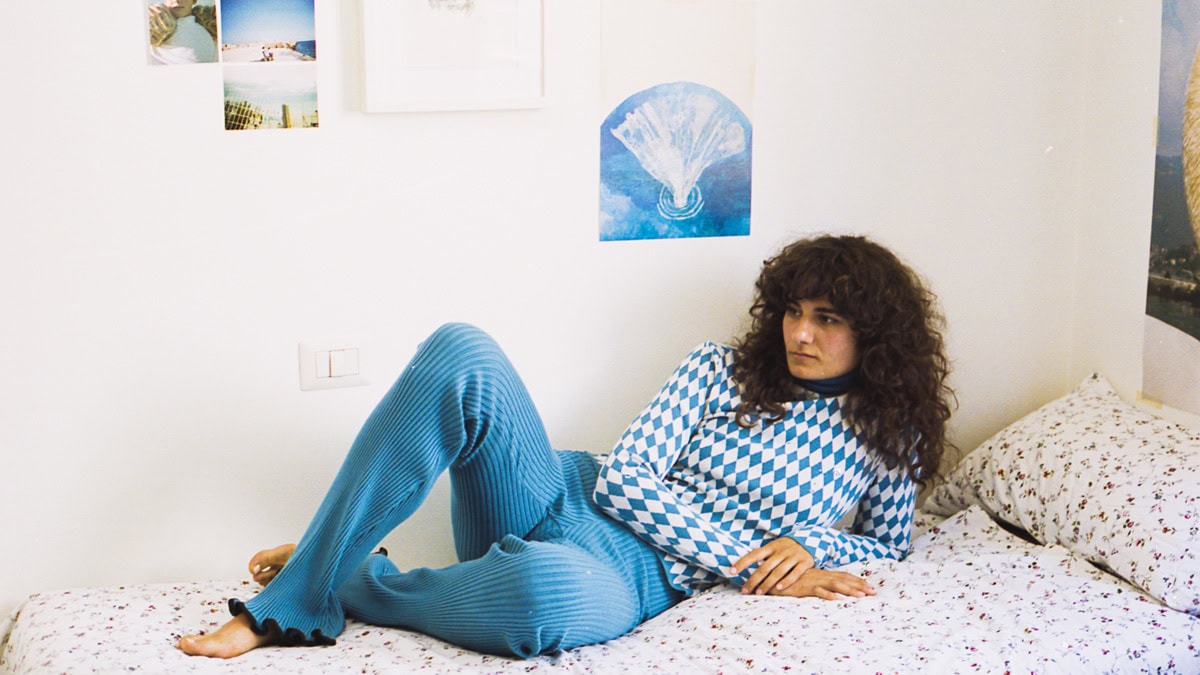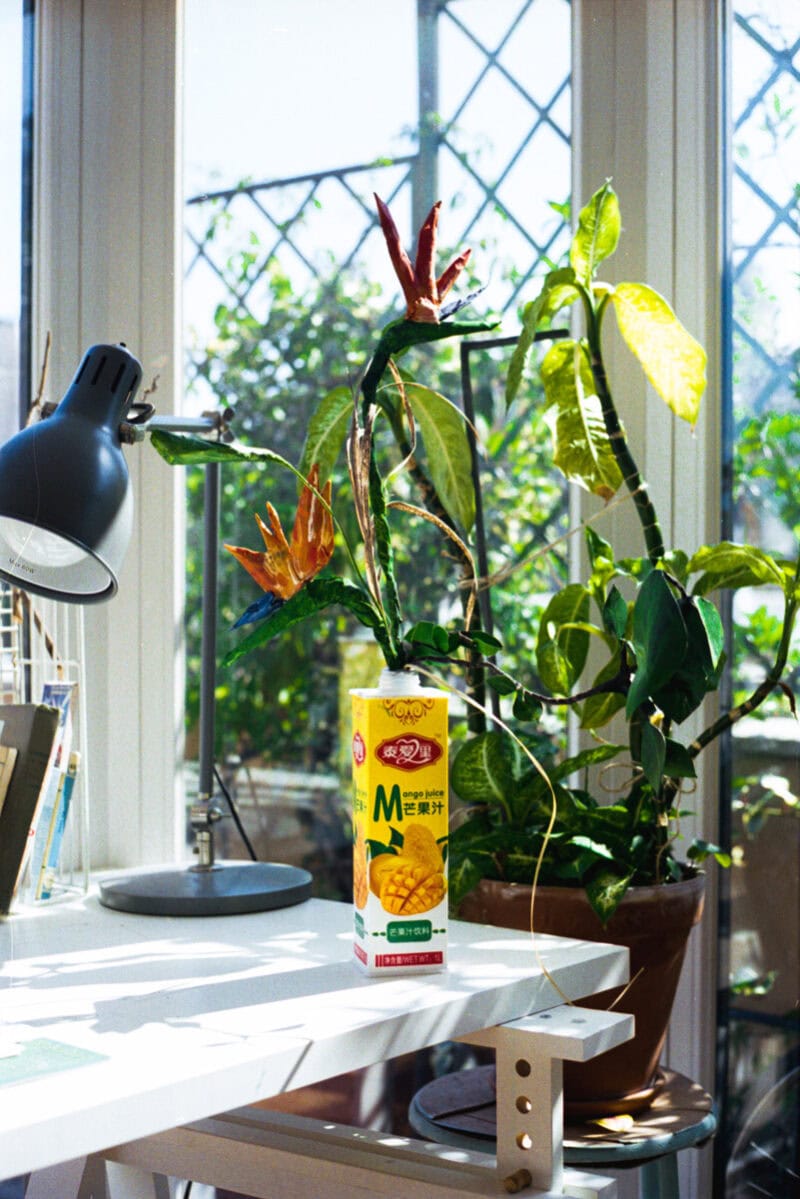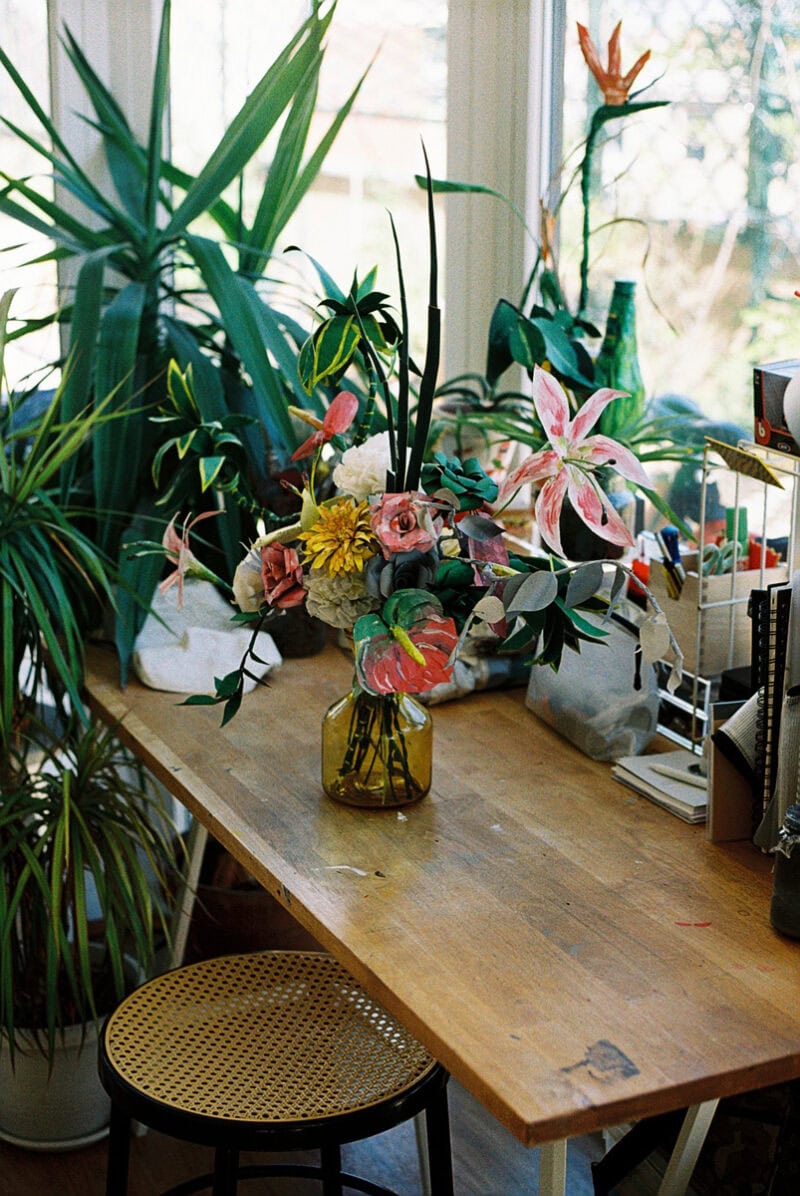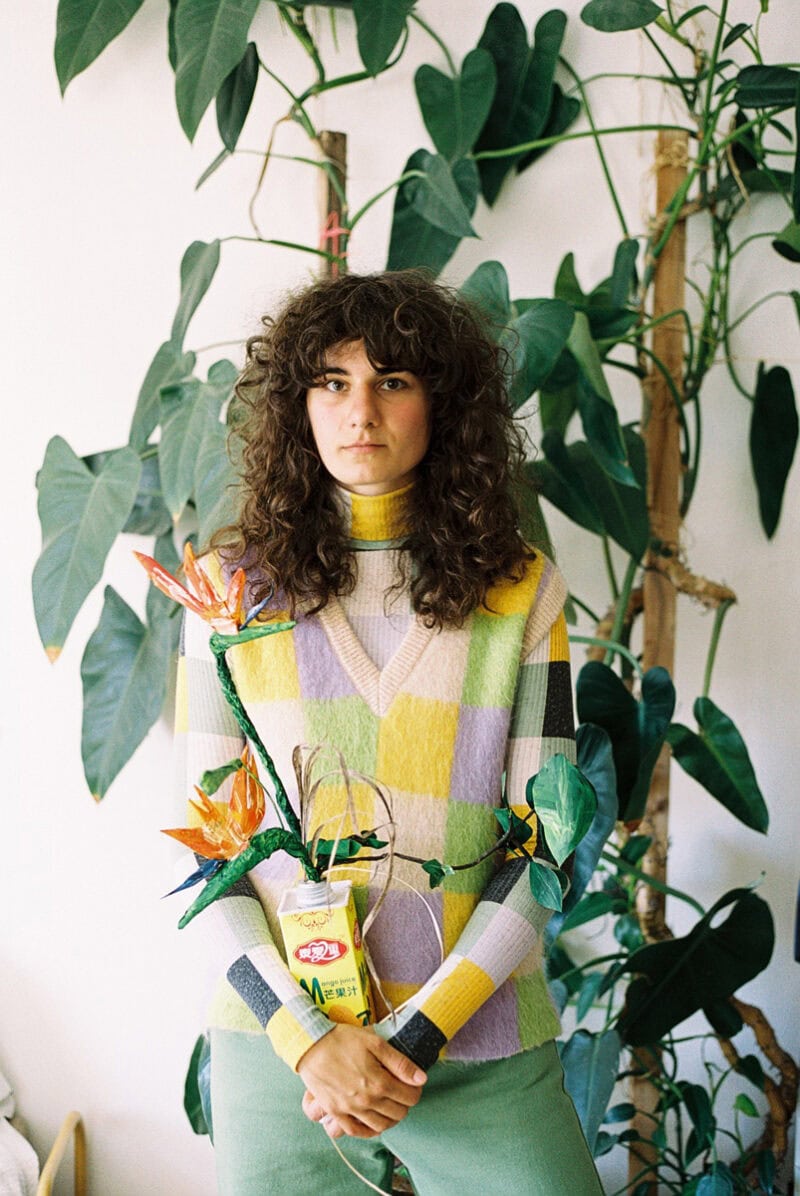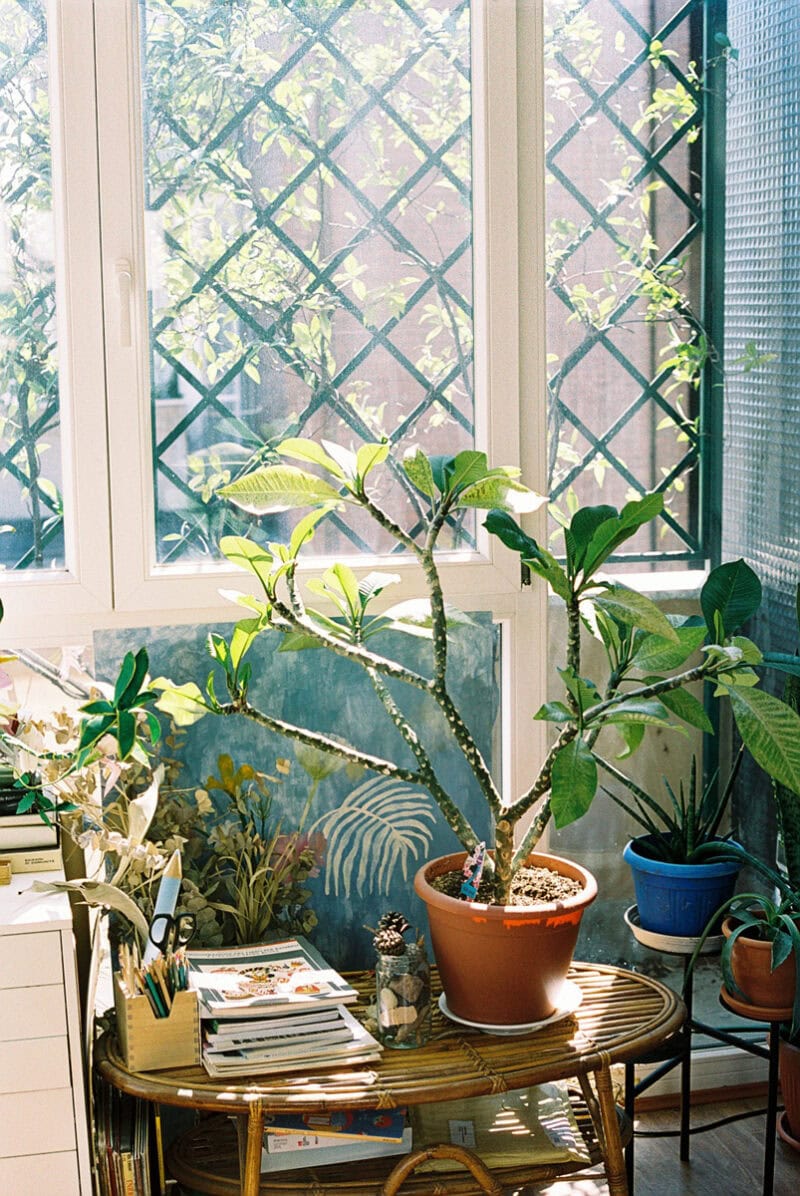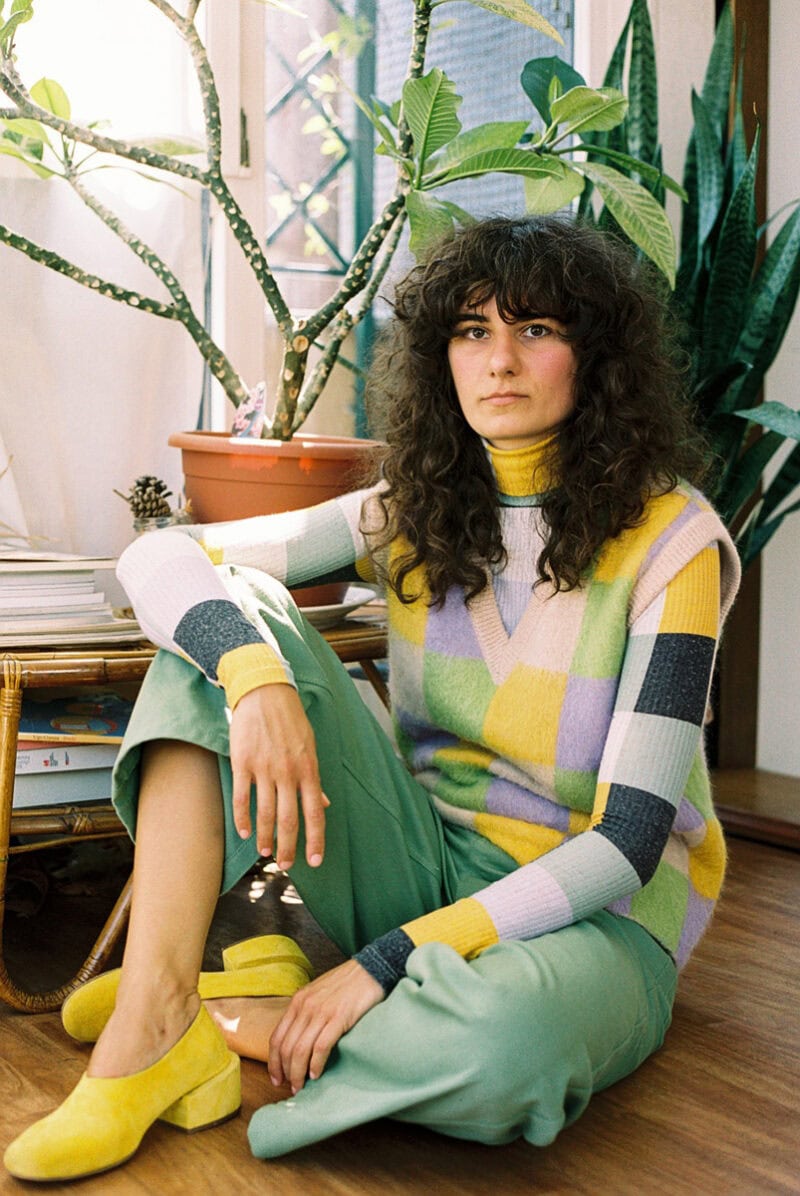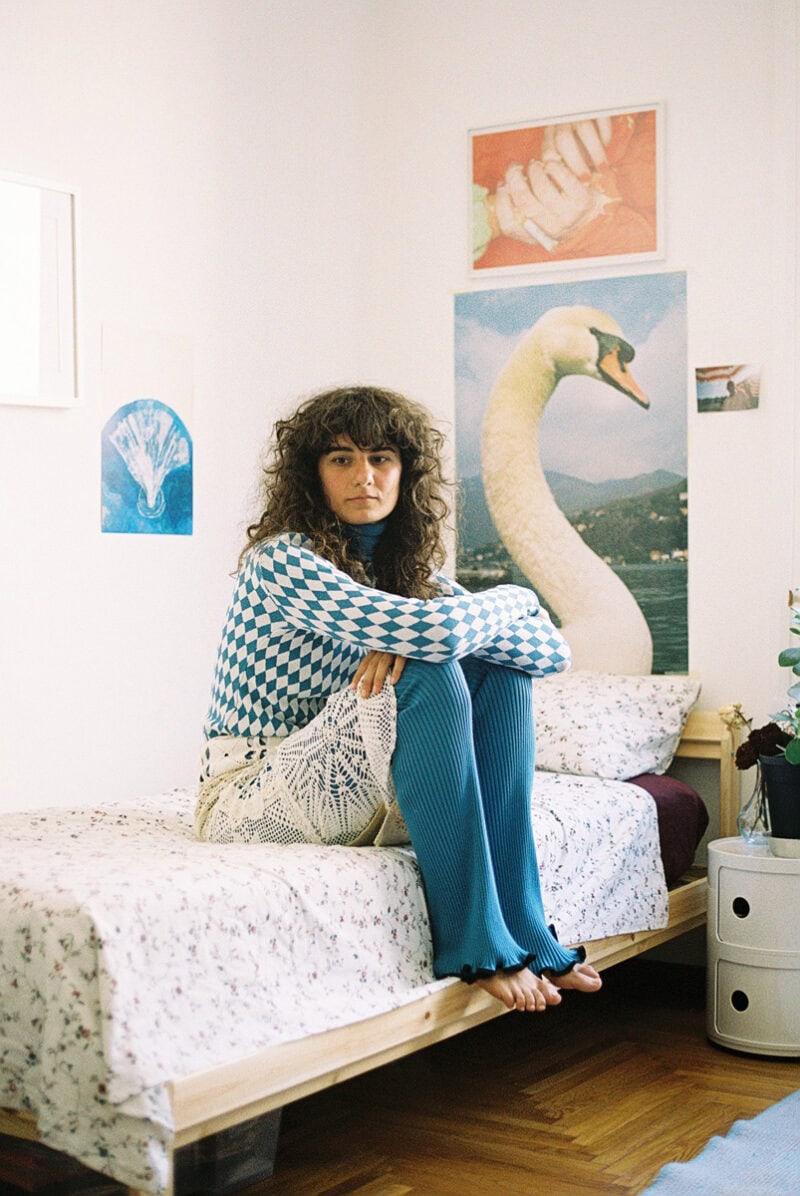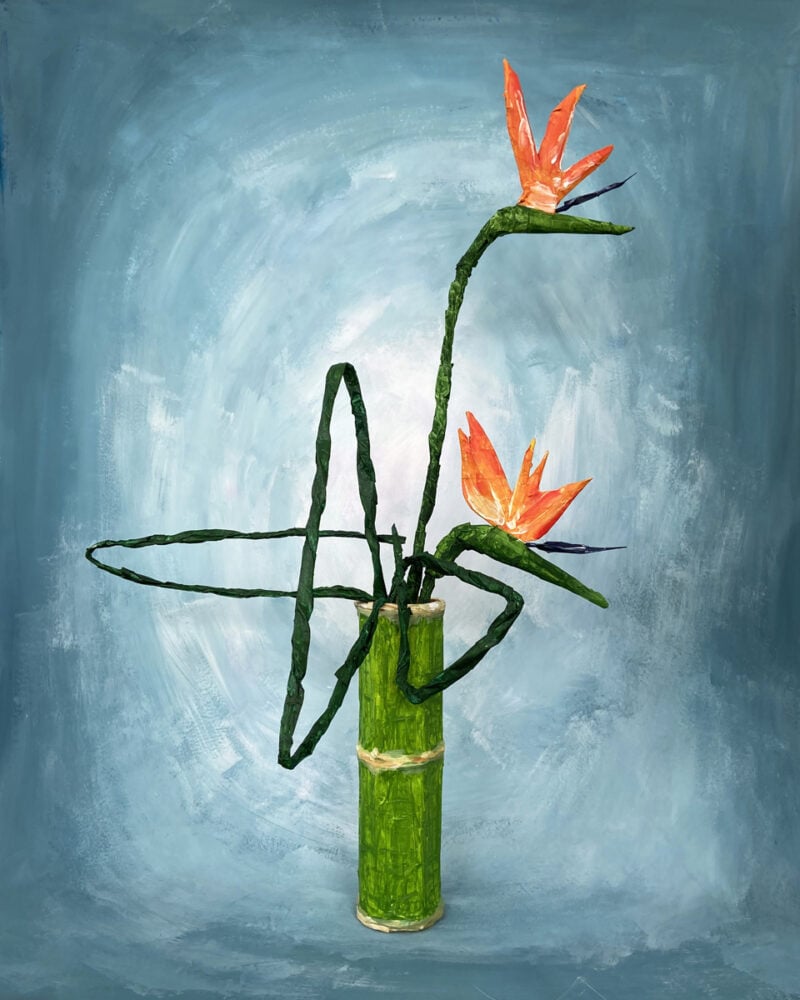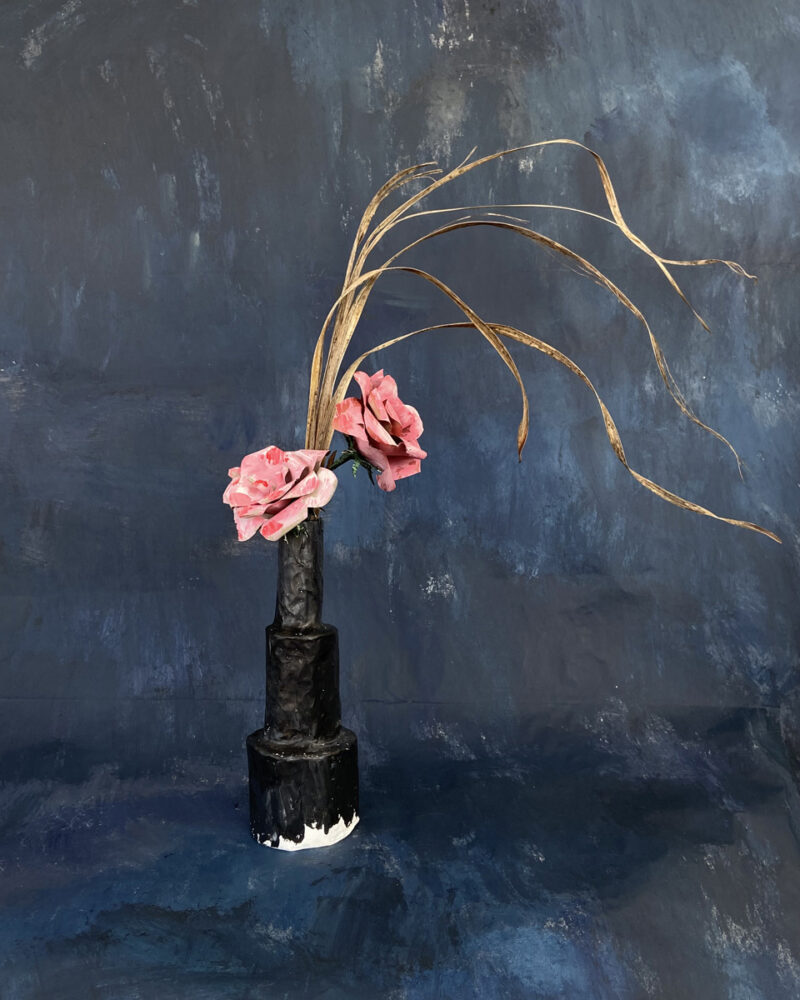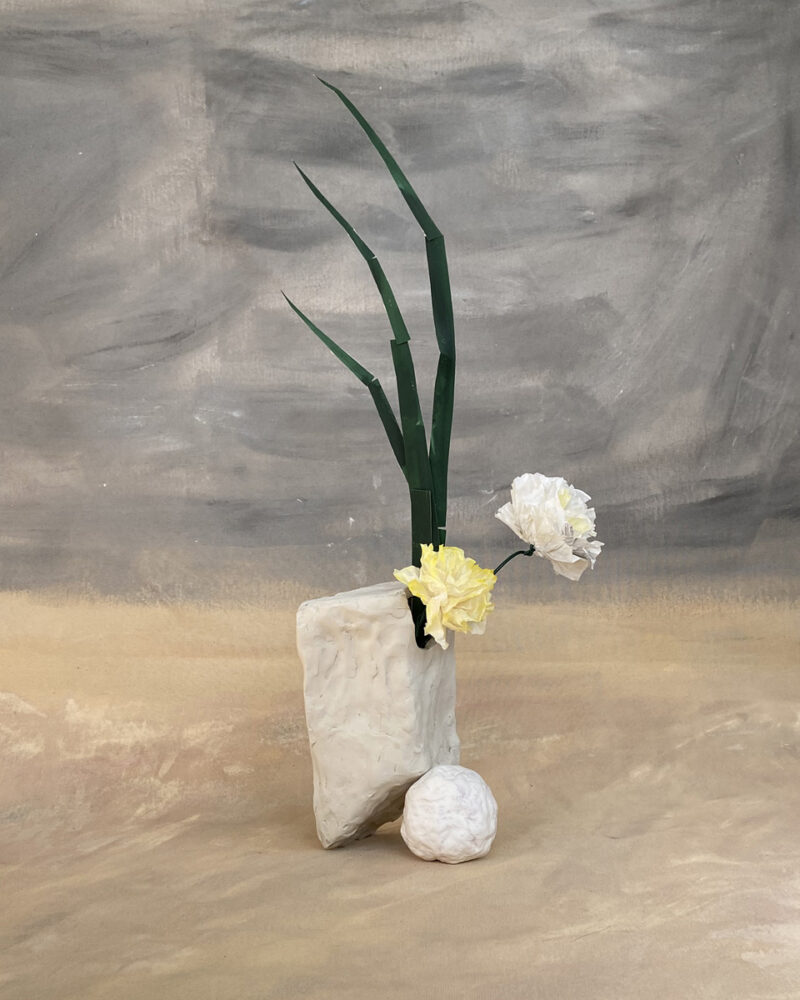Giuditta is art and instinct, simplicity and research. We have known each other for three or four years, since her first wonderful pen drawings but her art has evolved since then, becoming far more aware. As she also works as a set designer, she has developed new skills in various painting and sculpting materials and techniques. We last saw each other at her solo show at Galleria Inconsueta: Altissima, Purissima, ecc. A homage to supermarket water. Simple, intuitive, powerful.
More than a year has passed since then and everything came to a standstill for four months of that time. It was during those four months that Giuditta created a series of works released more or less weekly on her Instagram that came to our attention. Ikebana is another homage, this time to the ancient Japanese art of “living flowers”. Upon first glance, it is hard to distinguish whether the works are paintings, photographs, or sculptures. We were intrigued so we visited Giuditta in her home a few weeks after the end of lockdown. She shares a top-floor apartment between NoLo and Stazione Centrale, where the whole of north Milan spreads out below her.
Your work takes inspiration from inanimate objects, which you breathe life into through colours and shapes. Your Ikebana series references an ancient Japanese art that shares certain traits with your work? How did you come across this style?
I bought various books and magazines early on during lockdown, including Un Fiore con Amore by Munari. One evening, in search of inspiration, I started flicking through it, marking the pages that I liked best and researching the inspiration behind it. It opened up a whole new world to me. I like flowers and I like painting and Ikebana gives me the opportunity to show them in 3D because sometimes the flat page is not enough for me. In the art of Ikebana, each composition is carefully studied, and each component is positioned according to very precise rules and meanings. Looking back, I was unconsciously coupling the spirit with which Munari approached the theme with the precision and delicacy of eastern art, leading to compositions that were led “by feelings”.
The series could definitely evolve into an exhibition and installation, combining photography, art, and sculpture. Could you explain exactly how you made these pieces?
As I said, sometimes drawing isn’t enough for me – I feel the need to get stuck in with my hands too and bring more levels to the composition. In this case, I used papier-mâché vases and sculptures and painted backdrops that I already had or created especially. The flowers are made of paper, card and wire and then painted with acrylic. I started out watching tutorials on YouTube (another incredible world) but they looked completely different when I tried to recreate them of course! Interesting, nonetheless. I included some real elements (leaves, stones, etc.) to create just enough confusion that the spectator would stop to say, “What’s this… No, hang on… is that real? Is it all painted? Is it a photo?”
The lockdown certainly stimulated your creativity but how did you find it personally? Were you at your home-studio here in Milan? What was your routine?
There were multiple different phases. I was here at home in Milan and after the initial disconcertion at the idea of spending all that time (how long?) shut up at home, with the fear that I wouldn’t produce anything, I managed to get over my creative block myself thanks to Munari.
The first phase was very productive: from Ikebana to cooking (we cooked and ate a lot, like so many other people!), the quest for alternative pastimes (puzzles), and even sport!
We are lucky enough to have the terrace so we didn’t feel as closed in as we might have done.
To tell the truth, I then reached a phase where I had had enough. The curve began to decline, and I didn’t feel like doing anything, but I think this was fairly common. I spoke to other friends and people had stopped going out, stopped doing anything, everyone needed less energy, so had less appetite too. There was a lack of external stimuli, and we were all missing other people and time outside.
Reading, film, music, and art. Did you discover and explore anything in particular during this time?
I bought various different books, art books, and magazines, which I think is always a good investment and useful for finding inspiration. I also discovered comics, which I’d got to the age of 30 without ever reading. I started out last summer with Dr Pira and then bought all of Slam Dunk during lockdown. I’ve watched lots of different things: TV series (finally I had the time to dedicate to Breaking Bad!), films, especially Asian cinema, and animation (Midnight Gospel, Adventure Time, etc.).
Who did you speak most to and how? Did you spend more or less time on Instagram?
I was in touch with my friends and family via messages, video calls, and group calls. Something that pleasantly surprised me was the powerful need to keep in contact, not only with your close friends who you would speak to anyway, but people that you don’t often speak to or social media contacts. At a time in which we were deprived of our social lives, it was great to see this need emerge, especially because it really helped create or reinforce connections between people, at least in my case. I think this was probably one of the reasons that I spent more time on Instagram.
For those who don’t know, your house is practically a collective. There is creativity in the air here: from the prints and paintings hanging on the wall, to the books scattered all around, and the sketches on your desk. Who do you live with and how much do you all influence each other?
We moved here exactly three years ago, and we all knew each other already from various circles. Allison and Martina lived with my sister before I moved to Milan, so I knew them from staying with her at the weekends. Alli is a stylist while Martina is a pharmacist working in the cosmetics sector and currently studying naturopathy. Then there’s Elisabetta, who I met when living in Bergamo; she is an illustrator and art director. And finally Carlotta, an old friend of Alli’s who is studying singing, urban music production, and audio production.
As you can imagine, we all share our ideas and advice, both professional and otherwise. Whether it’s listening to unreleased tracks, helping with graphic layouts and illustrations, or treatments with Bach flower remedies. We also share our tastes in music, discovering new artists and going to gigs together, and cinema. In the kitchen we share recipes, tips and traditions handed down from our grandparents and aunts in Bergamo, Parma, Crema, and Pesaro.
In a previous interview, you described your style as “ignorant”, as a self-taught artist it was a humble but appropriate definition. How would you describe it today, five years down the line? From what I can see, you have acquired many more skills in terms of materials, techniques, and above all ideas.
I definitely made it up as I went a long a bit before, whereas I definitely know what I’m doing now. Something I do like however, is not getting too stuck on things, whether it’s technical or material. Depending on what I need or want to do, I choose something that will best adapt to my needs and if I can’t find the right medium, I’ll experiment with something else. I try not to worry too much about finding the right path, I almost let my hands guide the work and if it doesn’t come out right then it’s a sign that I need to change idea, style, or media. My style may have become more refined, but I think it’s true to say that my spontaneity hasn’t changed.
We met through your work at Galleria Inconsueta, which is doing some very interesting things here in Milan. What relationship do you have with the founders? Can you tell us about the projects you have presented together, and anything lined up for the future?
I met the GI team three years ago when they asked me to do a show for them (Brava Bravissima!) and we’re friends now. I can count on their help for all my projects, whether it’s a show in collaboration with them or my own solo show. That help may be to do with the content or technical issues and this collaboration has really helped me to grow.
After my first solo show, we presented another one in 2019 (Altissima Purissima ecc.) and I also took part in a collective show with other Galleria artists. It is an itinerant gallery, so the challenge lies in the space being different every time. I find it stimulating because it’s always a brand-new project, not solely in terms of the content. We have nothing planned at the moment, but curator Rosa Selavi’s mind never rests so I’m sure something will happen.
What is it like working with brands? Or rather, what is it like adapting your work to fit with a brand’s brief? What do they usually ask of you and how much freedom do they give you?
It depends. Sometimes the brief is very specific; they already have a clear concept and it just needs to be developed in my style. Sometimes they give some ideas to which I can respond with my own proposals, ideas, and sketches and then we work on it together.
I’ve been very lucky until now because I have been able to create artwork that represents me without distorting my work.
How did your collab with Off-White come about? And where is the original painting now? Will it ever be exhibited?
I was contacted by graphic designers who follow my work and they suggested me to Virgil Abloh. We worked on lots of different panels together and then as usual, one out of a million gets picked. The panels are all property of the brand, so I don’t know what they will decide to do with them.
One of your strengths is that your work resounds with everybody, from gallery owners to collectors, high-end brands, as well as grandparents and cousins. What does your family think of your art? Do you come from an arty family or is it more of a naïve curiosity in what you do?
I am very lucky that my family supports me in what I do, even though I’m not sure they fully understand it. They always come to my shows (granny included!) and want to know what I’m working on. My father has always painted, built things, and created so I think I’ve got that from him while my mum has the more scientific approach in the family so perhaps certain dynamics aren’t as immediate to her but she tries to understand.
Your work always features lots of snacks, beers, pizzas, and supermarket goods, and so does your Instagram (especially pizza and pizza with mayo). What is your relationship with food? Do you like going to restaurants? What is your favourite food and where do you like eating it?
I like eating of course, but as I’ve always cooked for myself, when I lived with my family too, I’m not in the habit of eating out a lot. I mostly eat our when I’m in the mood for different cuisines (Chinese, Korean, and pizza of course!).
I think I have quite simple tastes, most of the things I like best are quite simple. As an example, I’ve just got back from a holiday in Puglia and the food I liked the most there was the typical local focaccia with a mozzarella knot on top, eaten on the steps of the piazza. A grand total of 3 euros. I don’t feel the need to dine in Michelin-starred restaurants, if you know what I mean.
Your feed is very ironic, and we follow you not only for your work but for the fun content you post. What are some of the images that make you laugh the most? Have you ever thought of transforming them into works of art or are they two different areas?
I’m happy that this comes through from my feed! I’ve tried to be professional and only use Instagram to share my work, but I just can’t do it. In the end, that is also part of me and as you’ll have seen, I use Instagram as a diary in which I “write” anything that feels important to me in that particular moment. These images then directly or indirectly influence what I do. Sooner or later I’ll realise they have been of inspiration to me or they will appear as subjects in my work, in the meantime they are there on Instagram. I’m not a person of many words in general so perhaps it’s easier for me to communicate this way, through images of all sorts.
I’d like to finish off by asking a classic question: what would you like to do when you grow up? This is an uncertain time for everybody but current situation aside, how do you imagine your work will change over the next few years? Do you think you’ll stay in Italy or might you explore opportunities abroad?
In general I don’t think too much about the future. I don’t rule anything out, but I try to live in the present and assess any opportunities as they present themselves, as far as possible. So I don’t really know what I want to do when I grow up! I might say one thing but then life might take me in a completely different direction, perhaps even abroad, why not? Like I said, I like change, not sticking to the same thing, both in my work and the kind of work I do, which might vary from illustrating an article to set design for a shoot or something else entirely.
Do you feel a collective anxiety with regards to the future? How do you handle it, if so?
Yes, but that’s probably something common to my generation, especially those who work in the creative sphere (and freelancers even more so). I am quite positive generally speaking and I try not to get lost in pessimistic thoughts, it does happen sometimes of course, but generally my outlook is optimistic.
Credits:
Words by Riccardo Fantoni Montana
Photography by Carmen Colombo
Styling by Allison Papi
Art Direction by Isabella Petricca
Starring Giuditta Aresi
